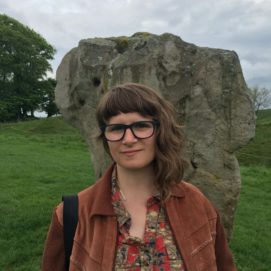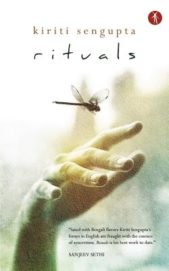A Discussion of Forms, Labor, the Feminine, and Public Space
by MC Hyland and Rebecca Lehmann
 Rebecca Lehmann is the author of the poetry collections Ringer (University of Pittsburgh Press, $17) which won the 2018 Donald Hall Prize for Poetry, and Between the Crackups (Salt, 2011). Her poetry and creative nonfiction have appeared in Tin House, Ploughshares, Boston Review, Copper Nickel, and other venues. She is an Assistant Professor of English at Saint Mary’s College in Notre Dame, Indiana.
Rebecca Lehmann is the author of the poetry collections Ringer (University of Pittsburgh Press, $17) which won the 2018 Donald Hall Prize for Poetry, and Between the Crackups (Salt, 2011). Her poetry and creative nonfiction have appeared in Tin House, Ploughshares, Boston Review, Copper Nickel, and other venues. She is an Assistant Professor of English at Saint Mary’s College in Notre Dame, Indiana.
 MC Hyland is the author of the poetry collections THE END (Sidebrow Books, $18) and Neveragainland (Lowbrow, 2010). She has also published a dozen poetry chapbooks/artist books, most recently Plane Fly At Night from above/ground press and the self-published Five Essays on the Lyric/The Laundry Poem with Anna Gurton-Wachter. She is the founding editor of DoubleCross Press, a poetry micropress, and recently finished a PhD in English at NYU. From her research, she produces scholarly and poetic texts, artists’ books, and public art projects.
MC Hyland is the author of the poetry collections THE END (Sidebrow Books, $18) and Neveragainland (Lowbrow, 2010). She has also published a dozen poetry chapbooks/artist books, most recently Plane Fly At Night from above/ground press and the self-published Five Essays on the Lyric/The Laundry Poem with Anna Gurton-Wachter. She is the founding editor of DoubleCross Press, a poetry micropress, and recently finished a PhD in English at NYU. From her research, she produces scholarly and poetic texts, artists’ books, and public art projects.
MC and Rebecca met at a writing residency in 2010, and conducted this conversation over Google Docs in the last week of August, 2019.
 MC Hyland: Let’s start by talking about the astonishing first poem in your new book, Ringer. Most of the poems in Ringer are really close to the ground: they speak to this historical moment as it’s experienced by a particular kind of subject. But in order to get to that specificity, you start with the poem “Natural History,” which begins at the creation of the earth: “Light hooks a claw on the horizon, pulls itself / into view”; land “climbs hydrothermal vents like stairs . . . hand-springing out of water.” This poem is a little bit Genesis and a little bit a parent obliging a child who demands to be entertained by stories. Did you always know this was where Ringer needed to begin?
MC Hyland: Let’s start by talking about the astonishing first poem in your new book, Ringer. Most of the poems in Ringer are really close to the ground: they speak to this historical moment as it’s experienced by a particular kind of subject. But in order to get to that specificity, you start with the poem “Natural History,” which begins at the creation of the earth: “Light hooks a claw on the horizon, pulls itself / into view”; land “climbs hydrothermal vents like stairs . . . hand-springing out of water.” This poem is a little bit Genesis and a little bit a parent obliging a child who demands to be entertained by stories. Did you always know this was where Ringer needed to begin?
Rebecca Lehmann: Thanks, MC. Your reading of “Natural History” is right on. I was envisioning a stacking of creation/origin stories—Genesis, the Big Bang, Evolution, human civilization—to sort of telescope in on the time and place of this book, which is the present, or near present, and mostly rural landscapes of the Midwest and Northeast. The final image in the poem, of the children sleeping in a tent and “Tina” hand-springing across the backyard, is from my own childhood in Wisconsin in the 1980s and ’90s. I grew up in a small town on a peninsula, and backyard sleepovers were a summer treat. My friend, Tina, who lived up the alley from me, was an excellent gymnast, and sleepovers would often feature cartwheeling, hand-springing, walking on hands, and other displays of female agility and strength. Originally, I began “Natural History” with Tina handspringing across the backyard, but I ended up flipping the poem in revision, re-writing it backwards.
Ringer went through a few different drafts, and the ordering of the poems changed quite a bit from version to version, but “Natural History” was always the first or one of the first poems, I think because it catches the play between despair and hope that runs throughout the book. Many of these poems are sad, or angry, or heartbroken, because I was writing about a time in my life when tragedies seemed to stack one atop another: I was depressed and isolated by living in a remote rural area in Upstate New York, I suffered postpartum depression after the birth of my son, I lost a pregnancy at THE END of the first trimester, I was sexually harassed by a student, I was trying to reconcile proto-fascist political changes. At the same time, wonderful things were also happening, like the birth of my son, and the glory of nature, which was all around me, literally consuming the abandoned houses, factories, and farms of New York’s North Country, an area with negative population growth and high rates of rural poverty. I liked “Natural History” as the first poem for Ringer because it catches some of that hope; it’s in many ways a sunny poem.
 Speaking of beginnings, I was so struck by the first sentence of THE END: “I got my period in the specialist’s office.” This book is amazing in its scope and the depth of its project, and I love how experiential it is, as its speaker moves through her life, and the city, and as specific tropes (the train, snow, texting, protests, the female body, common spaces, the Internet, poetic production) became richly developed themes. The first sentence of the book thrusts the female body front and center, and periods recur throughout the book, with repeated references to the experience of getting one’s period unexpectedly, in a bad time or place, calling up notions of the female body as unruly, misbehaving, inconvenient, or leaky. How integral is this theme to THE END, and how do you see it relating to larger social issues that run throughout the book, like protests, the idea of the commons, or the generation of poetry?
Speaking of beginnings, I was so struck by the first sentence of THE END: “I got my period in the specialist’s office.” This book is amazing in its scope and the depth of its project, and I love how experiential it is, as its speaker moves through her life, and the city, and as specific tropes (the train, snow, texting, protests, the female body, common spaces, the Internet, poetic production) became richly developed themes. The first sentence of the book thrusts the female body front and center, and periods recur throughout the book, with repeated references to the experience of getting one’s period unexpectedly, in a bad time or place, calling up notions of the female body as unruly, misbehaving, inconvenient, or leaky. How integral is this theme to THE END, and how do you see it relating to larger social issues that run throughout the book, like protests, the idea of the commons, or the generation of poetry?
MCH: That first sentence puns on a few of the book’s central concerns! THE END, like most of my writing, came out of a constraint I gave myself: to write one hundred poems composed of single-clause sentences. This meant that these sentences would contain only one kind of punctuation mark: the period. For me, poems are places where form is a tool that helps me think. In this case, syntax and that commitment to the number 100 (which, with the help of my editors, I ultimately condensed down a bit) helped me get at things I don’t think I would have known, otherwise, how to articulate.
As to where this form came from, and why the pun on (grammatical mark) “period” and (menstrual) “period”: I wrote THE END while doing a PhD in English literature. So I was trying, for the first time in years, to write critically—and like all unskilled critical writers, I was producing a lot of verbose prose. At the same time, I was thinking about the centrality of the sentence to Language writing: Ron Silliman’s essay, “The New Sentence,” Bob Perelman’s poem of half-sentences, “Chronic Meanings,” and Lyn Hejinian’s writing, with its massive, intuitive leaps between sentences. The single-clause sentence assignment was both a corrective and an experiment in applying the techniques of the ’80s to the present day. The period/period pun was irresistible, because I was consistently annoyed by both the masculinist critical tradition I found myself plunged into and the structural masculinism of universities as institutions. In general, THE END became a place to put all the thinking that didn’t fit in the classroom or in the seminar papers (and eventually, the dissertation) I was writing. The porous boundaries, leakages, and refusals of my own increasingly middle-aged body became a sort of metonym for all these undercurrents. A big part of these poems’ fascination with menstruation, incontinence, cosmetics, etc. has to do with thinking through the ways I experience my own body brushing up against larger systems of thought, of opportunity, and of control.
This brings me to two questions about Ringer. The first is about syntax: so many of these poems rely on declarative sentences, both metaphoric (“x is y”) and fact-stating (“it’s like this”). For example, from the poem “Today”: “Today’s real mother lives in California.” And in the poem “Elegy for Almost”: “It was as simple as this: I really wanted you/ and then you were gone.” Where does your sense of the sentence come from? Are there writers you think of as shaping your syntax? I have a feeling (and this is the second question) that there’s a link between the forms your sentences take and this book’s concerns with mothering, gendered rhetorical and non-rhetorical violences, and feminized and/or classed labor.
RL: Ringer definitely has an addiction to anaphora, which is one of my favorite rhetorical devices. When I was pregnant with my son, five years ago, I had terrible brain fog, and anaphora became a way for me to push a poem forward without having to give a lot of consideration to linearity of thought or narrative. This is how I wrote the poem “Epithalamion,” which uses the anaphoric refrain “when I was X, I dreamed I married Y,” and ends up becoming a consideration of place (this poem is strongly located in the upper Midwest) and heteronormativity. More to the point, anaphora is a formal technique that reflected my own experiences of the work of mothering small children as extremely repetitive (cleaning, bathing, walking a baby in a stroller, reading children’s stories, nap times, preparing food), and I think that’s why it’s so prominent in Ringer. I teach anaphora often, and two of the poems I use as models are “She Had Some Horses” by Joy Harjo and “Ballad of the Poverties” by Adrienne Rich. Both of these poets have been influential to me. In particular, I love Harjo’s use of direct address, how she will occasionally step out of her poems and start talking to the reader, commenting on the story she’s telling. That’s a move I enjoy making in my own poetry.
“Elegy for Almost” is by contrast a poem with very direct language. I wrote the poem in a moment of intense grief, after losing a pregnancy. I was diagnosed with a suspected molar pregnancy (a dangerous condition in which the pregnancy is no longer viable but can quickly threaten the health of the mother), and had to have an immediate abortion. My grief over this experience was so overwhelming that I found it almost impossible to write about it metaphorically, and so a lot of language in the poem is head-on (“I really wanted you / and then you were gone” or “Bad things happened”).
The opening stanza of “Elegy for Almost” refers to the 2016 presidential election, because I miscarried a week before the election of Donald Trump. I wrote “Elegy for Almost,” and then didn’t write for a couple of months, because I was grieving. When I did write again, around the time of Trump’s inauguration, I wrote the poems in Ringer that respond directly to Trump’s election and Trump as a figure. For me, these experiences, the miscarriage and the election, will always be connected, because they happened at the same time, but also because my experience with my miscarriage was an example of the personal being political. I was so grateful to be able to access a speedy and medically safe abortion when I needed one, performed in a hospital, by my obstetrician. Trump’s severe anti-abortion stance (that women should be punished for having abortions), coupled with his admitted sexual assault of women (grabbing them by their pussies), are both features of his paternalistic misogyny. At the same time, our nation has terrible maternal mortality rates, which are even worse for women of color. Furthermore, Trump’s attempts to disenfranchise women are intersectional with his racism, his weaponization of the southern border, his dog-whistle alignment with White Nationalists, and his position as an oligarch. The Trump poems in Ringer are my attempt to take up and respond to those issues.
This brings me back to THE END. The idea of the commons is so present in this book, be it a literal commons like a subway train, street, or protest, or a virtual commons like the Internet. Protests in particular are such a large facet of this book, and the protest becomes a commons that is both inclusive and exclusive, both a locus for public will and a product commodified and marketed by social media. Can you comment about the role of protests in THE END, and whether you were writing about specific protests or protest movements?
MCH: Your question reminds me of a conversation I recently had with some undergrads. I asked my students what changed with Donald Trump’s election, and one of them said: “there started to be widespread political protest.” But the Obama years were, in fact, filled with protest! Occupy, Black Lives Matter, and Standing Rock all brought protest into public spaces and shifted national conversations. (The same group of students also credited Bernie Sanders with the idea of “the 1%”: a fascinating example of the ways that the gains of protest—here, Occupy’s terminology—get folded into representative democratic systems.)
Most, if not all, of the protests that appear in THE END are Black Lives Matter vigils and marches in New York City. BLM profoundly changed my relationship to street-based protest. I came out of the Clinton-era media silence on protests—I remember participating, in college, in an action with the Kensington Welfare Rights Union (a homelessness advocacy group in Philadelphia), and there was all this media outreach, but no one from the media showed up. And then, in the early 2000s, there was a similar lack of coverage of the anti-Iraq War marches. I felt like those protests were really for the marchers’ benefit, because it was so clear that they couldn’t change the direction things were going. Of course, the thing that changed street-level protest was social media, which now usually leads the established media to the story.
Black Lives Matter demonstrations felt important for me to attend because they gave me a way to leverage my racial privilege to help make other marchers safer. They helped me understand the political and discursive power of being a body in a crowd. As a white person in America, I am often told that my particularities—my ideas, my feelings, my contributions, etc.—are what matter about me. But that’s not what matters about any person in either representative democracy or late-stage capitalism. In the contemporary world, we’re numbers far more often than we’re individuals. The distinction that Black Lives Matter makes—that law enforcement (along with other forces) tends not to allow Black people in America that same fantasy about the power of the individual—is an important theoretical intervention into our current moment. (Though, that said, even just the phrase “Black Lives Matter” feels like the teacher speaking slowly so the kids in the back—those of us whose lives have been shaped by racial privilege—can catch up to what everyone else already knows.)
Part of why the commons is so central to these poems is because they developed alongside my dissertation, which is about the way the history of the commons and of literary writing are, in the Anglophone world, entangled. Copyright, which originated in Britain and spread from there, was modeled on enclosure—the privatization of formerly common (or communally-worked open-field) land. I studied the ways poets, either intuitively or consciously, link questions of public and private space to questions of what it means to be an author. I looked especially at writing from the English Romantic period (also the peak years of enclosure) and the post-Cold War neoliberal era. In fact, you can sort of track the process of my research through THE END, based on when each of the four authors who I took as case studies show up. For example, early in THE END, I quote from William Wordsworth’s 1805 draft of the poem known, after his death, as The Prelude. There are also scattered references in THE END to Little Sparta, Ian Hamilton Finlay’s home garden. I also directly quote from Lisa Robertson, and, when I write about ornament, that’s often drawn from her thinking. And there’s a whole section of THE END which I wrote while on a three-month fellowship in London to work on a chapter on John Clare; in those poems I’m often turning over both Clare’s idiosyncratic writing and what critics have said about him. I had this routine, for a while, of going to the British Library, requesting my book-of-the-day in the reading room, and then working on the next THE END poem for half an hour before I started reading and taking notes. It felt deliciously illicit to be working on this secret book of poems while I was ostensibly there to Do Research.
Remembering those little stolen pockets of time in which I wrote THE END makes me want to ask you about the relationship between your writing and your paid work as a professor of creative writing. The poem “Academia” (with its statement: “you are not worth / the paper your teaching contract / was printed on”) indexes a number of problems of the contemporary university, as does “Exit Interview.” You’ve already talked about teaching—but I also keep thinking about how one of the things that Ringer is both leaning into and pushing against is the pressure to produce that the tenure system puts on poets. I feel like one of the controlled furies of your book is the need, in order to keep a job, to keep writing and publishing, constantly and quickly, through personal and communal tragedy.
RL: For the most part, I am deeply grateful to academia, because it has given me time to write. I grew up in a working class family, got my first job at fourteen, and worked as a waitress through high school and college. When I got into the MFA program at the Iowa Writers’ Workshop at twenty-two, it was the first time in my teenage or adult life that I didn’t have a job, and could focus singularly on writing. My PhD program, at Florida State University, functioned in much the same way. I’m lucky enough to have gotten a tenure track job, which affords me the time to focus on my own writing. None of that would be possible without the institutional support of academia, and I am so thankful to have had it. I’ve never felt like I’m under undue pressure to publish more than I want to or am capable of, in part because I’ve worked at teaching colleges, which have lower publication requirements for tenure, and in part because I write a lot, and send out my work frequently—that’s just who I am as a writer.
The poems in Ringer which you mentioned, “Academia” and “Exit Interview,” allude to some very specific experiences I had at my first tenure track job, about which I can only go into so much detail here. In short, a white student with White Nationalist tendencies accused me of being racist against white people, and then wrote a sexually explicit poem about me and turned it in for a homework assignment. I was scared of this student, and the way my institution handled the situation left me feeling abandoned. What became clear to me was that my institution was more concerned with presenting the sheen of inclusivity, diversity, and tolerance than with actually taking action when a problem arose. And, I knew that a colleague in my department who was black and LGBTQ+ was experiencing even worse pushback and isolation from the administration relating to explicitly racist death threats he had received from a student, so the problem seemed systemic. Ultimately, I ended up leaving that job, and I think that was a healthy choice.
To come back to THE END, I really want to ask about the overarching structure of the book. I thought so much as I was reading this about whether these were individual poems, or whether this was one long poem. Clearly, each poem is on its own page, and has a discrete beginning and ending, yet the poems all bear the same title “THE END,” and there is so much carryover of thought, theme, and style between poems, that this at times felt like a long poem masquerading as a poem in parts. Can you write a little about how you balanced the pull between the poem on the page and the longer piece? Was there a lot of movement in the ordering of THE END as you were revising and writing?
MCH: I never quite know whether this is, in fact, one long poem! When I was writing THE END, I often thought of what I was doing as writing individual sentences. Once I had a page of sentences (which sometimes took one sitting, and sometimes a month), I would make some tweaks and cuts and arrange them into a page-sized unit. And once it felt like that set of sentences was working together, I’d start gathering new sentences for the next page.
As to order, the poems in this manuscript have always been arranged in order of when they were written. The changes I did make had to do less with order than with editing adjacent poems together. The poems at the beginning of THE END often combine two or three earlier draft-poems. Jason Snyder, my editor, helped me see the ways in which the book, at 100 poems, took a while to find its rhythm, and I re-wrote (or re-edited) accordingly. The first 25 poems that I wrote for this project have their own life as a 2017 chapbook published by Magic Helicopter Press. I love that the whole 100 “THE END” poems are out there, but divided between these two publications. The poetry chapbook is my favorite print genre, and I like that THE END, as a full-length book, doesn’t totally subsume the poems that were first gathered in that format.
Click here to purchase Ringer
at your local independent bookstore

Click here to purchase THE END
at your local independent bookstore

 Kiriti Sengupta
Kiriti Sengupta


 Rebecca Lehmann is the author of the poetry collections Ringer (
Rebecca Lehmann is the author of the poetry collections Ringer ( MC Hyland is the author of the poetry collections THE END (
MC Hyland is the author of the poetry collections THE END (
